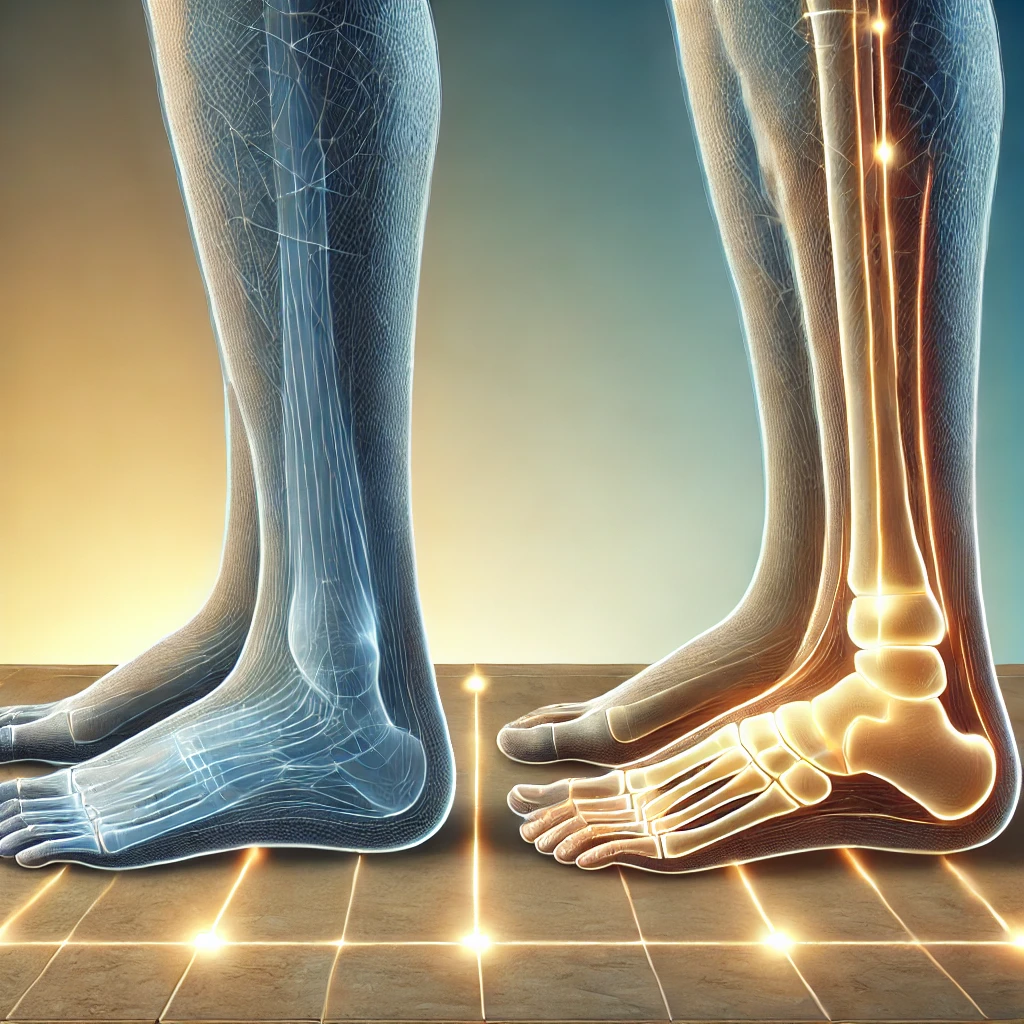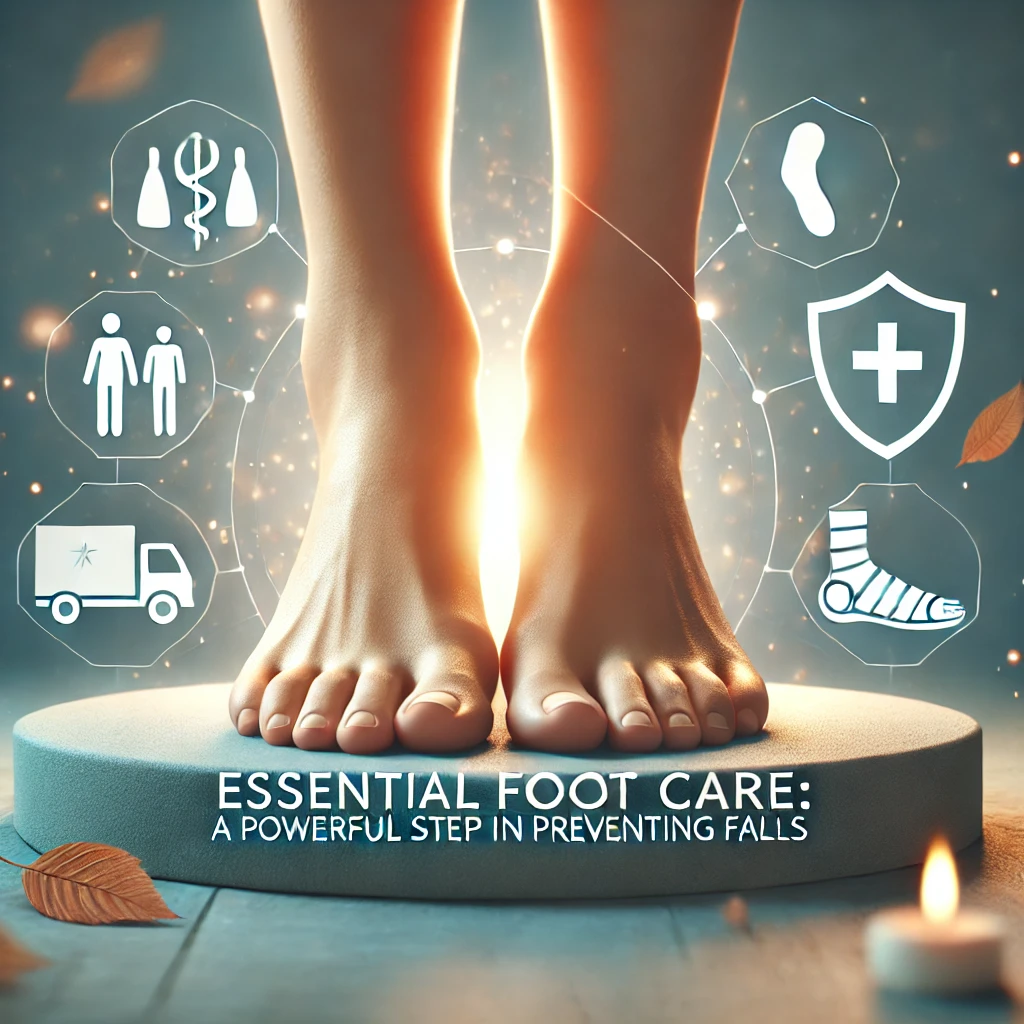Introduction
Our feet might seem like the most unassuming part of our bodies, but they play a pivotal role in how we stand, walk, and even feel. When your feet aren’t in good shape, it’s not just about occasional discomfort—it can lead to long-term problems, including poor posture. Posture isn’t just about how you stand; it’s about how your entire body aligns, from head to toe. And guess what? It all starts with your feet.
In this article, we’ll explore how foot health directly impacts posture, the science behind this connection, and practical steps to improve both. Whether you’re dealing with pain or simply curious about how to keep your body in balance, this guide will cover it all.
Understanding Foot Anatomy
The human foot is a marvel of engineering. With 26 bones, 33 joints, and over 100 muscles, ligaments, and tendons, it’s designed to bear the entire weight of your body. The arches of your feet—whether they are low (flat feet), normal, or high—act as shock absorbers, distributing your weight evenly.

When these structures are compromised, the consequences ripple upward. For instance:
- Arches: Overpronation (flat feet) or underpronation (high arches) can create misalignment.
- Muscles and Ligaments: Weak or tight muscles can impact how your feet interact with the ground.
- Joints: Problems in the ankles or toes can lead to compensatory movements, affecting the knees, hips, and spine.
A strong, flexible, and balanced foot provides the foundation for proper posture, allowing the body to align naturally and avoid undue strain.
What is Posture?

Posture refers to the way we hold our bodies, whether standing, sitting, or moving. Good posture means that your muscles and joints are balanced, minimizing stress on your body. There are two main types:
- Static Posture: How you hold yourself when you’re still.
- Dynamic Posture: How you move while walking, running, or performing activities.
Poor posture often results from prolonged sitting, improper footwear, or foot abnormalities. Over time, this misalignment can lead to chronic pain in the back, neck, and shoulders.
The Role of Feet in Body Alignment
Imagine building a house on a shaky foundation—it won’t be stable, right? The same applies to your body. Your feet are the base of your entire skeletal system. If they’re off balance, it affects everything above them.
Here’s how it works:
- Kinetic Chain: The body operates as an interconnected system. When one part is out of alignment (like your feet), it triggers a chain reaction affecting the knees, hips, and spine.
- Postural Shifts: Common foot problems, like collapsed arches, can tilt your pelvis and curve your spine, creating discomfort and reducing mobility.
Properly aligned feet keep your body in balance, ensuring smooth and pain-free movement.
Common Foot Problems That Affect Posture
Flat Feet and Their Impact

Flat feet, or fallen arches, occur when the arch of the foot collapses, causing the sole to touch the ground entirely. While some people experience no symptoms, others may face severe postural problems due to the imbalance flat feet create.
- Impact on Alignment: Overpronation, a common effect of flat feet, causes the ankles to roll inward. This misalignment shifts stress upward to the knees, hips, and lower back.
- Increased Wear and Tear: Poor distribution of body weight can strain muscles and joints, leading to conditions like shin splints or lower back pain.
- Posture Issues: People with flat feet often develop a forward-leaning posture to compensate, further exacerbating musculoskeletal problems.
Treatment options like supportive footwear, custom orthotics, and strengthening exercises can significantly improve foot function and posture.
High Arches and Posture Misalignment

High arches, or cavus feet, are the opposite of flat feet. Here, the arch is overly pronounced, causing an imbalance in weight distribution.
- Pressure Points: Individuals with high arches tend to put excessive pressure on their heels and the balls of their feet, leading to instability.
- Misaligned Gait: Over time, this can cause an uneven gait, knee pain, and even stress fractures.
- Spinal Effects: The lack of shock absorption from high arches increases the impact on the spine, potentially resulting in chronic discomfort.
Custom insoles, cushioning footwear, and physical therapy can help redistribute weight and reduce postural strain.
Bunions, Plantar Fasciitis, and Other Foot Ailments

Other foot conditions can also lead to posture problems:
- Bunions: Misaligned toe joints push the big toe inward, disrupting balance and gait.
- Plantar Fasciitis: Inflammation in the plantar fascia leads to heel pain, forcing individuals to adjust their walking patterns, which impacts overall alignment.
- Hammer Toes: These deformities cause uneven pressure during walking, which can ripple into knee and hip issues.
Early diagnosis and treatment, including orthotics, physical therapy, or surgery, can mitigate these problems.
The Impact of Poor Posture on Overall Health

Effects on the Spine, Hips, and Knees
Poor posture caused by foot problems doesn’t just stay in the feet. It travels up the body, affecting major joints like the knees, hips, and spine.
- Spinal Misalignment: A misaligned gait or uneven weight distribution can lead to conditions like scoliosis or herniated discs.
- Knee Stress: Incorrect foot positioning increases the wear and tear on knee cartilage, often leading to osteoarthritis.
- Hip Pain: Compensatory adjustments in walking patterns strain hip muscles, leading to joint degeneration.
Chronic Pain and Reduced Mobility
When poor posture persists, chronic pain becomes inevitable. Common areas include the lower back, neck, and shoulders, limiting mobility and flexibility. For active individuals, this means difficulty performing daily tasks or participating in sports.
Psychological and Physical Consequences
Chronic pain from poor posture can also take a toll on mental health. People often experience stress, frustration, and a reduced quality of life due to physical limitations. Correcting posture not only alleviates pain but also boosts confidence and energy levels.
The Science Behind Foot Health and Posture
Research Studies Linking Foot Health to Posture
Numerous studies highlight the connection between foot structure and body alignment. For example, research shows that individuals with flat feet are more prone to knee and hip problems, while high arches correlate with spinal issues. These studies emphasize the importance of foot health in maintaining an upright posture.
Biomechanics and Gait Analysis
Understanding how the body moves is key to addressing posture issues. Biomechanics and gait analysis assess foot movement during walking, revealing abnormalities that can be corrected through therapy or orthotics.
Innovations in Understanding Foot-Posture Connections
New technologies, like pressure-mapping insoles and 3D scanning, provide deeper insights into how feet interact with the ground. These tools help customize treatments, ensuring better alignment and reduced pain.
How to Assess Your Foot Health and Posture
Signs of Foot-Related Posture Issues
- Persistent pain in the feet, knees, hips, or back.
- Noticeable wear patterns on shoes, indicating uneven gait.
- A tendency to slouch or shift weight to one side.
Self-Assessment Techniques
- Mirror Test: Stand barefoot and observe your posture. Are your shoulders even? Do your arches collapse inward?
- Footprint Test: Check your wet footprint; a flat or overly curved print can indicate structural issues.
When to Seek Professional Help
If pain or misalignment persists, consult a podiatrist, physical therapist, or chiropractor. Early intervention can prevent long-term complications.
Exercises to Improve Foot Health
Strengthening and Stretching Routines
- Toe Curls: Strengthens the arch and improves flexibility.
- Calf Stretches: Loosens tight calf muscles, relieving tension in the feet and ankles.
- Ankle Rotations: Enhances joint mobility and balance.
Yoga Poses for Foot Health and Posture
- Downward Dog: Stretches the entire posterior chain, including the feet.
- Tree Pose: Improves balance and strengthens foot muscles.
Tools Like Resistance Bands and Massage Balls
Using resistance bands for foot exercises and massage balls to relieve plantar fascia tension can enhance strength and flexibility.
Footwear Choices and Their Role
Importance of Supportive Shoes
Supportive footwear provides stability and reduces the risk of postural issues. Look for shoes with proper arch support, cushioning, and a snug fit.
How Ill-Fitting Shoes Harm Posture
Shoes that are too tight, loose, or lack support force your feet into unnatural positions. This misalignment can ripple up to the knees, hips, and spine.
Tips for Choosing the Right Footwear
Your choice of footwear has a direct impact on your posture and overall foot health. The wrong shoes can create misalignments that ripple up through your body, affecting your knees, hips, and spine.
Key Factors to Consider
- Arch Support: Shoes with proper arch support help distribute weight evenly, reducing the strain on your feet and lower body.
- Cushioning: Adequate cushioning absorbs shock and minimizes the impact on your joints.
- Fit: Ill-fitting shoes—whether too tight or too loose—can cause blisters, bunions, and balance issues.
Practical Tips
- Test Before Buying: Walk around in the shoes to ensure comfort and stability.
- Replace Worn Shoes: Over time, shoes lose support, so replace them regularly, especially athletic footwear.
- Specialized Needs: For flat feet or high arches, consider custom orthotics or supportive brands designed for your condition.
Investing in the right footwear is an essential step toward maintaining proper posture and avoiding unnecessary pain.
Orthotics and Custom Insoles

Orthotics are a game-changer for individuals struggling with posture issues stemming from foot problems. They are designed to provide support, correct alignment, and enhance comfort.
Role of Orthotics in Correcting Posture
Orthotics work by redistributing pressure and realigning your feet. This improves your walking patterns, reduces strain on joints, and promotes better posture.
Types of Custom Insoles
- Rigid Orthotics: Made from firm materials like carbon fiber, these provide strong support and are ideal for correcting major alignment issues.
- Soft Orthotics: These are made from pliable materials like foam and are excellent for cushioning and reducing pressure points.
- Semi-Rigid Orthotics: A hybrid option for those needing a balance of support and flexibility.
Benefits and Limitations
Benefits:
- Reduce pain in the feet, knees, and back.
- Improve walking and running efficiency.
- Prevent further deterioration of foot conditions.
Limitations:
- They can be costly, especially custom-made options.
- Require a breaking-in period for maximum comfort.
Orthotics, when paired with proper footwear and physical therapy, can significantly enhance both foot health and posture.
The Connection Between Gait and Posture

Your gait—how you walk—plays a pivotal role in determining your posture. An uneven gait can lead to misalignments and chronic pain over time.
Understanding Gait Cycles
The gait cycle consists of two phases:
- Stance Phase: When the foot is in contact with the ground.
- Swing Phase: When the foot moves forward to take the next step.
A balanced gait ensures even weight distribution and minimizes stress on the joints.
Identifying and Correcting Gait Abnormalities
Common gait abnormalities include overpronation, underpronation, and limping. These issues can be corrected through:
- Gait analysis: Performed by professionals to assess walking patterns.
- Exercises: Strengthening weak muscles and improving flexibility.
- Orthotics: Correcting structural imbalances.
Importance of Proper Walking Techniques
Adopting the right walking posture:
- Keep your head up and shoulders relaxed.
- Engage your core for stability.
- Land softly on your heels and roll through to your toes.
These adjustments can dramatically reduce the risk of foot-related posture issues.
Professional Interventions for Foot and Posture Issues
Physical Therapy and Podiatry
Physical therapists and podiatrists specialize in addressing foot and posture-related problems through targeted interventions:
- Therapeutic Exercises: To strengthen foot muscles.
- Manual Therapy: To improve joint mobility and reduce pain.
Chiropractic Care
Chiropractors focus on spinal alignment, but they also address foot-related posture issues by:
- Adjusting joint misalignments.
- Providing guidance on orthotics and supportive footwear.
Advanced Treatments for Chronic Conditions
For severe or chronic conditions, advanced options include:
- Surgical Interventions: For bunions, severe flat feet, or other deformities.
- Shockwave Therapy: To treat plantar fasciitis or heel spurs.
- Custom Orthopedic Devices: To support and stabilize the foot.
These treatments ensure that even complex issues don’t become long-term obstacles.
Preventive Measures for Healthy Feet and Posture

Daily Habits to Maintain Foot Health
- Stretch Regularly: Loosen tight muscles in your feet and legs.
- Practice Good Hygiene: Keep feet clean and moisturized to prevent infections.
- Stay Active: Engage in weight-bearing activities like walking to strengthen bones and muscles.
Preventing Injuries Through Proper Care
- Warm up before exercise to avoid strains.
- Use proper footwear for sports and daily activities.
- Address minor issues, like blisters or corns, before they escalate.
The Role of Regular Check-Ups
Regular visits to a podiatrist or physical therapist can:
- Identify early signs of foot or posture issues.
- Provide tailored advice for maintaining alignment.
- Prevent small problems from turning into chronic conditions.
Conclusion
Your feet are the foundation of your posture, and neglecting their health can lead to a cascade of issues affecting your entire body. By understanding the link between foot health and posture, investing in supportive footwear, and adopting preventive measures, you can maintain balance and avoid unnecessary pain. Whether it’s through orthotics, professional interventions, or simple daily habits, prioritizing foot care is the key to a healthier, more aligned you.
Frequently Asked Questions
1. How can poor foot health lead to back pain?
Misaligned feet can cause compensatory shifts in posture, straining the lower back and leading to chronic pain.
2. Are custom orthotics worth the investment?
Yes, custom orthotics are designed to address your specific foot structure and posture issues, offering significant relief and better alignment.
3. How often should I replace my shoes?
Replace shoes every 300-500 miles of wear or whenever you notice diminished support and cushioning.
4. Can yoga improve foot health?
Absolutely! Poses like Downward Dog and Tree Pose strengthen foot muscles and enhance balance, supporting better posture.
5. When should I see a podiatrist?
If you experience persistent foot pain, difficulty walking, or postural misalignments, it’s time to consult a professional.










